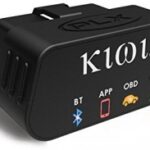Many users of Harry’s LapTimer, a popular tool for performance data analysis, sometimes encounter issues when connecting via OBD2. These problems can range from slow initial connections to inconsistent data delivery. This guide will address common OBD2 connection problems in Harry’s LapTimer and provide troubleshooting steps to improve your experience.
One initial hurdle can be a slow or unsuccessful negotiation of the bus protocol. While this usually resolves itself after the initial connection, it can make startup noticeably longer. To address this, you can manually set a Default Protocol within Harry’s LapTimer’s expert settings (Administration â–ȉ Settings â–ȉ Expert Settings â–ȉ OBD Tweaks). If you’re unsure which protocol your car uses, the SCANTOOL app (OBDLink) can help identify it.
Even with a successful connection, older vehicles with pre-CAN bus systems often have slower data reply times. The best response times might be around 130ms, which translates to approximately 7 to 8 PIDs (Parameter IDs) per second. This limits Harry’s LapTimer to a display update rate of only 1 or 2 Hz. Unfortunately, there’s not much that can be done to overcome this inherent limitation of older bus technologies. They simply aren’t capable of delivering data faster than about 10 PIDs per second, resulting in that 1-2 Hz refresh rate.
A more critical issue is the frequent occurrence of “NO DATA” replies. This indicates that a data request from Harry’s LapTimer to your car’s OBD2 system has failed, which should ideally not happen. When “NO DATA” replies occur, the system waits for a timeout, further reducing the data update rate and impacting the smoothness of data display in LapTimer.
To mitigate “NO DATA” replies, first ensure you have enabled “Ignore NO DATA/NAK Replies” in Harry’s LapTimer’s Expert Settings. Additionally, reducing the Reply Timeout to 0.30 seconds can help. These adjustments can lessen the impact of “NO DATA” replies, though they may not completely eliminate them.
For a more robust workaround to “NO DATA” replies, consider switching the Adaptive Timing setting from “Optimized” to “Enabled”. While “Optimized” is generally preferred for well-functioning OBD2 setups, enabling “Adaptive Timing” can often eliminate “NO DATA” replies. This trade-off may result in a consistent but still limited update rate of 1 or 2 Hz, which is the maximum achievable with slower bus systems anyway.
By understanding these common issues and applying these troubleshooting steps within Harry’s LapTimer’s settings, you can optimize your OBD2 connection and improve your data acquisition experience, even with older vehicle systems.
